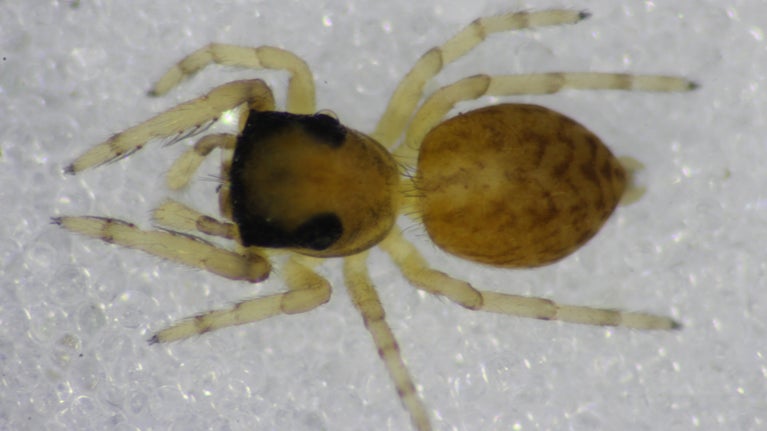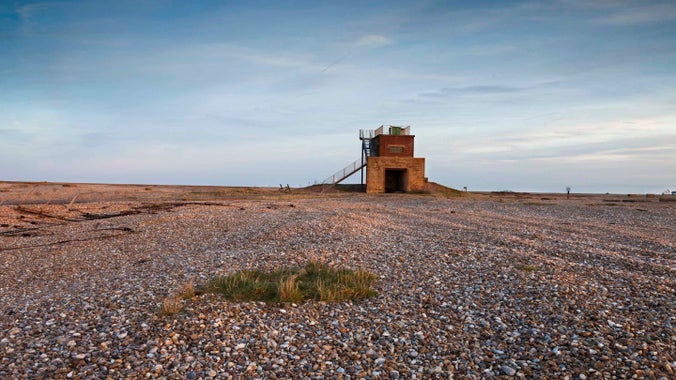Orford Ness ‘crawling’ with spiders as survey reveals new record of rare spider species for the wild and remote location
- Published:
- 30 October 2024

As we approach Halloween, recent surveys by spider experts have revealed that the wild and remote Orford Ness, cared for by the National Trust, is ‘crawling’ with spiders.
A total of 55 species of spider have been identified, including 12 believed to be nationally rare or scarce, and a first-time record for the Suffolk coast of the nationally rare Neon pictus.
The type of jumping spider has previously only been found in six other locations across Britain at sites hundreds of miles away on the south coast. A real life incy wincy spider, the females typically measure just 3mm in length and are only found in shingle habitats.
The discovery was made during two surveys carried out this year at the internationally important nature reserve and former 20th Century military testing site in Suffolk by the British Arachnological Society [1].
Five nationally rare spiders were recorded along with seven nationally scarce species of spider; nationally rare species are found in far fewer places in Britain [2]. One, the rare Gnaphosa lugubris spider, is thriving in the stony coastal grass and heathland habitat and although usually identified in only very small numbers, due to the numbers counted, experts think Orford Ness could be home to several thousand.
Matt Wilson, the National Trust’s Countryside Manager for the Suffolk and Essex Coast, says: “It’s great to have identified a new species of spider on Orford Ness along with confirming that the other rare species last recorded in the early 2000’s can still be found here. Whilst the photographs we have may make them look fierce, many are so small that they were unlikely to have been found by non-experts and their equipment.”

The fragile coastal habitat at Orford Ness consists of 2,000 acres of reed marshes, mud flats, brackish lagoons and delicate shingle ridges and valleys. Twenty per cent of Europe's vegetated shingle is found there and one single misplaced footstep can destroy structures that have taken centuries to form. It’s in these fascinating habitats that the arachnids are thriving.
Matt continues: “The coastal marshes along with the challenging shingle environment here offer habitats for several different types of 'specialist’ species, and the presence of so many of these, as well as their high numbers, indicates a generally healthy habitat. Although shingle habitats are prone to damage by leisure and commercial activity, we believe the remote nature of Orford Ness, where disturbance is limited, may be helping these spider species to succeed.”
The largest shingle spit in Europe, Orford Ness also has an abundance of wildlife including several species of nesting and wading birds such as avocets, redshank and lapwing, along with marsh harriers, hares and Suffolk’s first colony of breeding grey seals.
Two members from the British Arachnological Society carried out the surveys on Orford Ness with SSSI consent from Natural England. The charity is Britain’s only one dedicated exclusively to Britain’s 670 species of spider and their relatives – the arachnids.
Richard Gallon from the British Arachnological Society said: “Orford Ness is one of the UK’s premier sites for specialist coastal shingle spiders. The rainy weather on our first survey in May wasn’t ideal. Jumping spiders in particular are sun-worshippers, and tend to hide away in poor weather, so we weren’t expecting to find many of these.
“However, despite the weather, we soon located the nationally scarce Pseudeuophrys obsoleta hiding in empty Whelk shells on the shingle – its favoured retreat. The highlight of the survey came towards the end of that day when a small jumping spider was spotted clinging to the underside of a rock – this was Neon pictus. We were delighted to find this species at Orford, as it extends the known UK range of this nationally rare species into East Anglia.
“Other spider records made during the survey are also important, confirming the continued presence of several rare and scarce species on the site.”
Ben McCarthy, Head of Nature Conservation & Restoration Ecology at the National Trust concluded: “It’s brilliant to see the results of this survey on one of our most extraordinary wildlife sites. Unlike most of our sites, Orford Ness has a relatively short history of biological recording as it was largely closed to the public until the 1990s when the National Trust acquired it.
“Since then its importance keeps on growing and especially for its fantastic invertebrate fauna including these wonderful spiders. It’s great to see that the careful management of the site’s habitats - from shingle to saltmarsh to grasslands to wetlands - support so many of these often maligned but important species.”
National Trust rangers carry out regular surveying and monitoring of species on Orford Ness to inform conservation work and habitat management.
Nesting, breeding and winter bird surveys, butterfly transects and moth trapping, and water vole and otter monitoring are just some of those carried out alongside more specialist surveys like the spider survey. A network of trail cameras also provides rangers with insight into new arrivals and glimpses of shyer resident inhabitants.
Orford Ness is now closed to the public for the winter and reopens in April 2025. To find out more about the National Trust’s work on the nature reserve or to plan a visit next year go to: www.nationaltrust.org.uk/orford-ness-national-nature-reserve